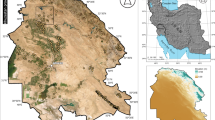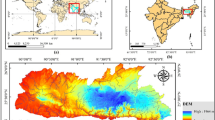Abstract
Infrastructural development is time consuming and costly, especially for highways in rugged mountainous terrains which are typical of the Eastern Mediterranean. Doing it properly requires an economic and time effective approach. The Australian P.U.C.E. (Province. Pattern, Unit. Component Evaluation) terrain evaluation system is such an approach. It proved very efficient in evaluating the terrain of the mountainous Chouf area in Lebanon. This helped to assess a 18 km stretch of highway.
The smallest land division in the system serving the highway project is the Component level. The study involves the use of aerial photos, and checking representative field stations along the highway. Surficial geology, geomorphology and engineering geological characteristics constitute the basic data used.
Twenty nine Components are obtained and quantified in terms of slopes, soils types, land use and vegetation association. The highway is bordered mostly by steep slopes with gradients in the range 50–90 percent. They are often covered by mass movement colluvial soils indicating general instability. There are sixteen soil types of various mixtures from clays to gravels showing a wide range of consistency limits. Similarly, vegetation density and type vary with the different soils and slopes with which they are associated. Rock formation characteristics and the effects of water induce additional instability problems.
The final assessment of the highway is made by finding its suitability over ten segments delineated according to dominant land use. Input factors consisting of geology, topography, erosion, hydrogeology, structural geology, soils, vegetation, cost and man's activities are weighted over each highway segment. The aggregate total of weights, ranging from less than 17 to 26, are split into five suitability categories. The least suitable category, total less than 17, covers almost 40 percent of the highway which means it needs major maintenance works.
Résumé
Le développement des infrastructures routières, et en particulier des autoroutes en terrain montagneux tourmenté, est long et coûteux; ce sont pratiquement toujours ces terrains que l'on rencontre en Méditerranée orientale. La réalisation de ces autoroutes nécessite une approche économique efficace. Le système australien P.U.C.E. (Province Pattern Unit Component Evaluation) utilise une telle approche. Il s'est avéré très efficace pour l'évaluation des terrains dans la zone du Chouf au Liban, lors de l'étude de 18 km d'autoroute.
La subdivision la plus petite du système utilisé dans le projet d'autoroute est du niveau de l'“élément”. L'étude comprend l'utilisation des photographies aériennes et une vérification des conditions de terrain le long de l'autoroute. Les données de base utilisées comprennent la géologie de surface, la géomorphologie et la géotechnique.
Vingt-neuf “éléments” sont mis en évidence et quantifiés, concernant les pentes, les types de sols, l'occupation des sols et la végétation. L'autoroute est bordée essentiellement de pentes raides, entre 50 et 90% Elles sont souvent recouvertes de sols colluviaux glissés caractéristiques d'un état d'instabilité. Il y a seize types de sols avec des mélanges variés depuis les argiles jusqu'aux graviers, leur consistance variant dans de larges proportions. De même, la densité de la végétation et les espèces végétales varient selon les différents types de sols et de pentes. Les caractéristiques variables des massifs rocheux et les effets de l'eau induisent des problèmes d'instabilité supplémentaires.
L'évaluation finale de l'autoroute se traduit par une estimation de la faisabilité de dix sections successives délimitées en tenant comple de l'occupation dominante des sols. Les facteurs pris en compte sont la géologie, la topographie, l'érosion, l'hydrogéologie, la géologie structurale, les sols, la végétation, les coûts et les activités humaines. La pondération des facteurs permet de définir cinq catégories de faisabilité. La moins favorable couvre 40% du tracé concerné ce qui suppose d'importants travaux d'entretien.
Similar content being viewed by others
References
BARNETT D.M., EDLUNG S.A. and DREDGE L.A. 1977: Terrain characterization and evaluation: An example from Eastern Melville Island. Geol. Surv. Canada, pap. 76–23, 18 p.
BEAUMONT T.E. and BEAVEN P.J., 1977: The use of satellite imagery for highway engineering in overseas countries. (T.R.R.L. Transport & Road Research Laboratory) England, Supplementary Report 279, 19 p.
BEAVEN P.J. and LAWRANCE C.J., 1981: Terrain evaluation for highway planning and design. T.R.R.L. 892, pp. 36–46.
DAVIDSON D.A., 1982: The assessment of land use capability. (I.S.S.G.L.F.—Proc. 1st. Intl. Symp. on Soils, Geology and Land Forms). Impact on Land Use Planning in Developing Countries. Bangkok, April 1–3, pp. G2.1–G2.57.
DUMBLETON M.J., 1973: Available information for route planning and site investigation. T.R.R.L. Report 591, 25 p.
FINLAYSON A., 1984: Land surface evaluation for engineering practices: Applications of the Australian P.U.C.E. system for terrain analysis. Quarterly Jour. Eng. Geol. 17: 2: 149–158.
FINLAYSON A. and BUCKLAND A.J., 1987: The use of terrain evaluation for urban and regional planning. Geol. Soc. Hong Kong, Bull. 3: 67–79.
FOOKES P.G., SWEENEY M., MANBY C. and MARTIN R., 1985: Geological and geotechnical engineering aspects of low-cost roads in mountainous terrain. Eng. Geol., 21: 1/2: 1–17.
GRANT K. 1970: Terrain classification for engineering purposes of the Maree Area, south Australia. (CSIRO-Common Wealth Scientific & Industrial Research Organization) Division of Soil Mechanics. Technical paper. No. 4. 297 p.
GRANT K., FERGUSON T. G., FINLAYSON A.A. and RICHARDES B.G., 1981: Terrain analysis, classification and evaluation for urban and regional developmental purposes of the Albary—Wodonga area, N.S.W. and Vic., CSIRO, Division of Applied Geomechanics, Technical paper, No. 30, 226 p.
GRANT K., 1982: Land capability assessment and evaluation for land use planning (I.S.S.G.L.F.), pp. G3.1 – G3.45.
G.S.L., 1982: Land surface evaluation and engineering practices. Report by a working party. Geological Society, London. Quart. Jour. Engl. Geol. 15: 4: 265–316.
JONES D.K.C., BRUNSDAN D. and GOUDIE A.S., 1985: A preliminary geomorphological assessment of part of the Karakoram highway. Quart. Jour. Eng. Geol. 16: 4: 331–345.
KHAWLIE M.R. and HASSANEIN H.I., 1984: Engineering geology of the Hammana landslides, Lebanon. Quart. Jour. Eng. Geol. 17: 137–148.
KHAWLIE M.R., 1985: Mass movements: A national plan for their assessment in Lebanon. Proc. GEOCOME II, October 22–24, 1983, Baghdad, Iraq. 141–147.
KHAWLIE M.R., 1986: Land-use planning for the redevelopment of a disrupted urban centre: Beirut, Lebanon. Intl. Jour. for Development Technology, 4: 267–281.
KHAWLIE M.R. and A'WAR R., 1988: Terrain analysis for development studies: Typical mountainous area along the eastern Mediterranean coast—Lebanon. Intl. Assoc. Eng. Geol. Bull. 38: 95–104.
SPANGLE W. and ASSOCIATES, 1976: Earth science information in landuse planning. U.S. Geol. Surv. Circ. No. 72, 28 p.
TRRL, 1978: Terrain evaluation for highway engineering and transport planning. A technique with particular value for developing countries. TRRL, Supplementary Report, No. 448, 21 p.
Author information
Authors and Affiliations
Rights and permissions
About this article
Cite this article
Khawlie, M.R., A'war, R. Terrain evaluation for assessment of highways in the mountainous eastern mediterranean of Lebanon. Bulletin of the International Association of Engineering Geology 46, 71–78 (1992). https://doi.org/10.1007/BF02595036
Published:
Issue Date:
DOI: https://doi.org/10.1007/BF02595036




